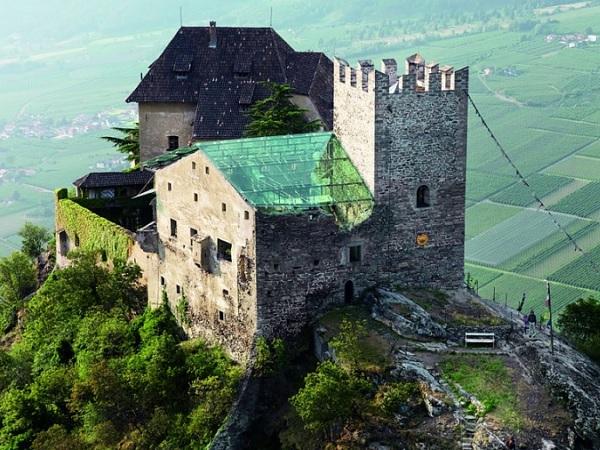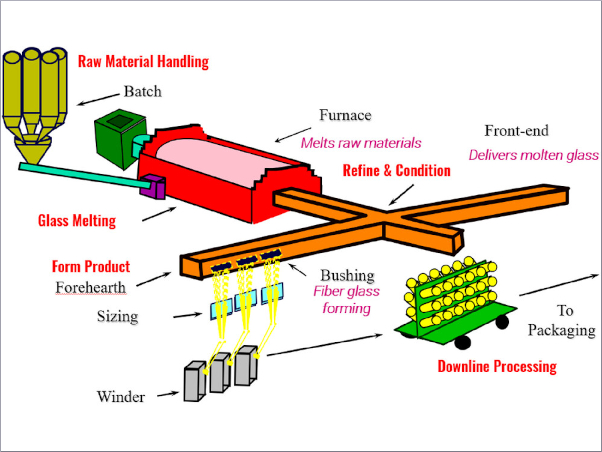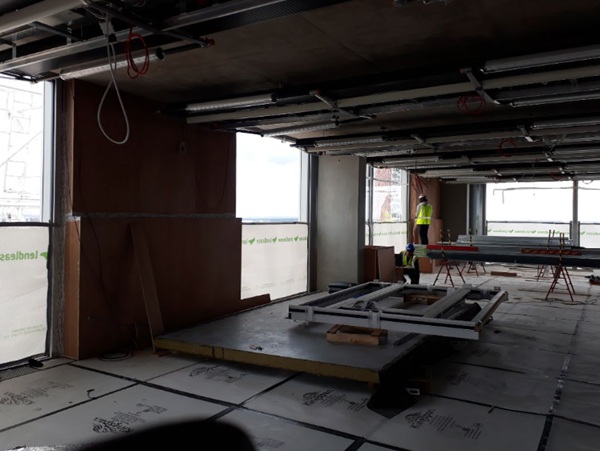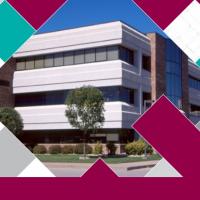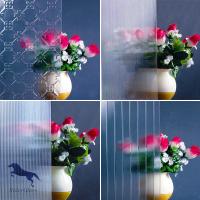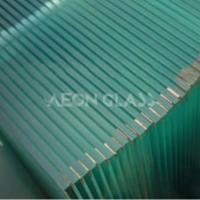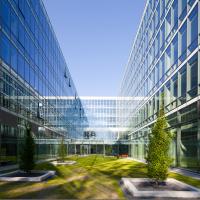Current restoration and conservation treatments with traditional materials bear the risk of conjecture between the original and new elements, whereas the high consolidation demands often result in visually invasive and irreversible solutions. Nowadays, aspects of materiality and aesthetics appear as integral parts of the restoration practices, indicating new materials and technologies in the form of ambiguous gestures rather than absolute and permanent manifestations that prevail over the historic structures. The inherent transparent properties render glass a distinct material that enables the simultaneous perception of the monument in both its original and ruinous state.
The emerging technologies have set the ground for using glass in a structural way minimizing the need for substructure and maximizing transparency, while protecting the sensitive historic materials. The paper explores the feasibility of this concept addressing aspects of structural compatibility, reversibility and aesthetics, through a review of realized examples. Finally, a methodology is developed to relate the glass products, available in the market today, to the possible consolidation treatments in respect to the degree of intervention and representativeness, stressing the potential of using and considering glass as a promising restorative material.
1 Introduction
The conservation of our built heritage, in other words the architectural conservation, is an inseparable part of our cultural and national identity and ensures its existence to the future. Structures that have survived over time are imbued with values (e.g. historic, social, aesthetic) shaped throughout the multiple layers of history, and trigger our emotions to form what we acknowledge today as cultural significance. From castle ruins and vernacular architecture to archaeological sites, the aim is not only to preserve building stock, scientific testimonies of the past or “conserve material for its own sake” (Avrami et al., 2000, p. 7); but to maintain all those values embedded in heritage settings and create a sense of belonging and familiarity, as aspects of our collective memory which enrich our present life.
Any physical interventions or treatments should only serve as means to achieve this purpose. Contemporary conservation philosophy, as stated in the Charter of Venice (ICOMOS 1964), aims to actions that should be distinguishable in order to reflect their time and avoid falsified interpretation of the original structures. On the one hand, the stratification of the building should by no means be concealed and on the other hand the new materials should not be disguised, enabling an honest dialogue between the old and new, the past and present. Moreover, the principle of reversibility suggests that every intervention should give the possibility for future removal, either due to the development of new technologies or in case it proves inadequate or fails.
1.1 Materiality debate: restore or preserve?
In the dawn of the 21st century restoration practice appears more extreme and bold than ever, targeting materiality as topic of discussion and questioning. Theory and practice are contradicting resulting in two opposing movements, an on-going debate between restoring and preserving. This conflict between safely restoring a historic structure and at the same time preserving its identity, according to the conservation guidelines, stems from the fact that repairing actions refer to modern materials, technology and process (D’Ayala and Forsyth, 2007, p.6).
While historic structures were designed and built in a different era and with a different function, their consolidation today is based on the structural demands and building or sustainability codes for contemporary structures showing the way for the use of modern materials. This becomes crucial in cases such as the rehabilitation of monuments for current use; the ambition to meet the desirable safety codes and structural performance of modern structures may be followed by invasive treatments that can permanently damage the historic fabric.
At the same time, without careful attention, modern materials could impose themselves on the historic buildings impairing, in such way, their authentic image (Fig. 1a). Conservative treatments with traditional materials can result in less intrusive solutions, bearing, however, the risk of conjecture between the original and new elements (Fig. 1b). Consequently, the curators find themselves in an internal conflict, being asked to respect and leave the monuments “untouched” applying reversible solutions, but at the same time efficiently safeguard them for future generations.
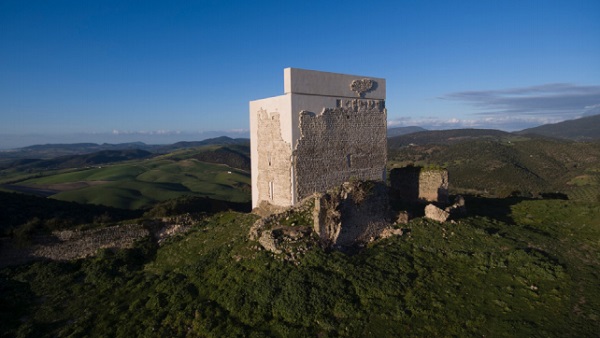

As materials are the main physical expression to maintain and make the values embedded in a historic setting revive, a lot of attention is placed on the harmonic articulation between the existing and the new. Aspects such as the aesthetics, physical and mechanical properties, connections and compatibility of the new materials with the historic ones are of vital importance. Any addition or reparation on the existing structure should not interfere with its internal or external natural actions. For instance, historic masonries should not be repointed using mortars that are impermeable and block the natural “breathing mechanism” of the walls, forcing moisture to evaporate through the historic materials and eventually deteriorate them.
Modern materials are very different from historic ones (regarding their physical, mechanical, chemical properties), however the emerging technologies allow for their implementation in a smart way in order to achieve a better performance. As original materials were chosen to satisfy a purpose in a certain context, which no longer exists, the use of contemporary materials and techniques appears more pertinent reflecting our time, culture and society (Fig. 2a, b and c). If architectural conservation is assumed to be the process of managing the change (Orbasli 2008), what better way to leave our trace as a society of continuous change, technological advancements and innovation?


1.2 Transparency: an answer to the materiality debate
If we take a look at artistic restorations, which are free of building regulations and standards, we notice a tendency to circumvent this materiality debate introducing material and immaterial means to form an open dialogue between the old and new. What if we stopped trying to materialize and instead try to dematerialize the bygone fragments of our built heritage? What if the demonstration of a compact form, could be replaced by vague gestures that appear visible and invisible at the same time? Transparency and translucency represent this idea of blur interpretation of materiality, a tool widely used by artists to create a sense of space continuity and juxtaposition between the existing and the new. Where architects are limited by building standards to efficiently consolidate the decayed materials, artists interpret the image of the historic structures in the present setting free of restrictions and regulations.
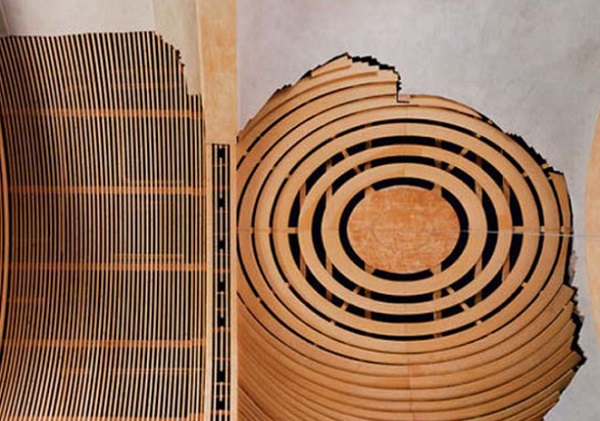
Artistic restorations and repairs show a trend towards transparent means in order to complement the original volumes and express the “authentic image” without imposing on it. One way to generate transparency is to give the outline of the general shape of the missing object using frameworks (Fig. 3a and b). The Basilica of Siponto (Fig. 3d), by the Italian artist Eduardo Tresoldi (2017), is one of the finest examples of conceptual transparent restoration.
The use of wire mesh in his works creates a material and immaterial result that tricks the eye, while this transparency “narrates shape and space of the absent matter as a representation of something that was there and then disappeared”. The other way to generate transparency is with the actual use of transparent materials, as in the case of the artist Tatiane Freitas, who repairs old wooden furniture with acrylic elements to fill the form and give a simultaneous perception of its original and current state (Fig. 3c). Thus, inspired by artists, such ambiguous solutions could also be the answer to the current materiality dilemma, between restoring and preserving, by using materials, which appear existent and non-existent, visible and invisible.
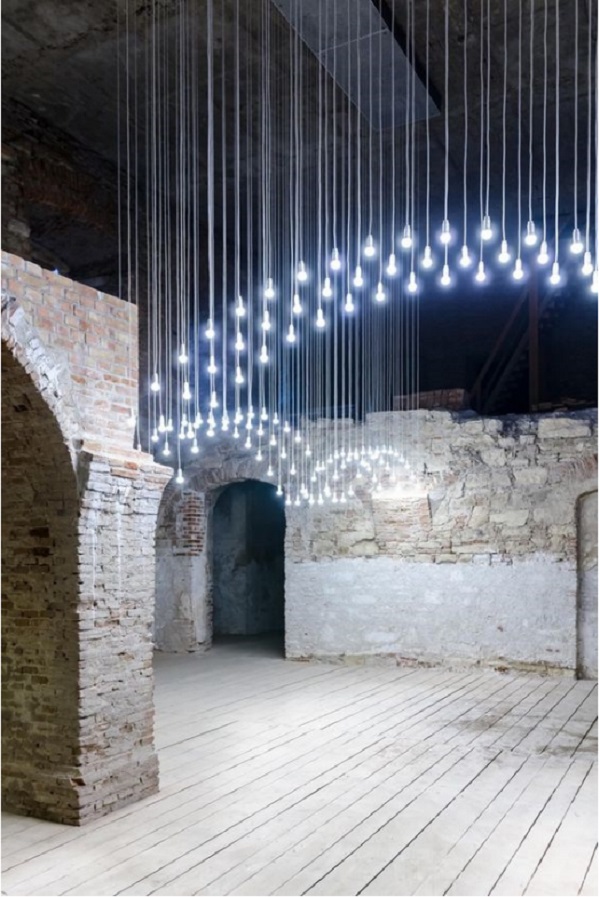
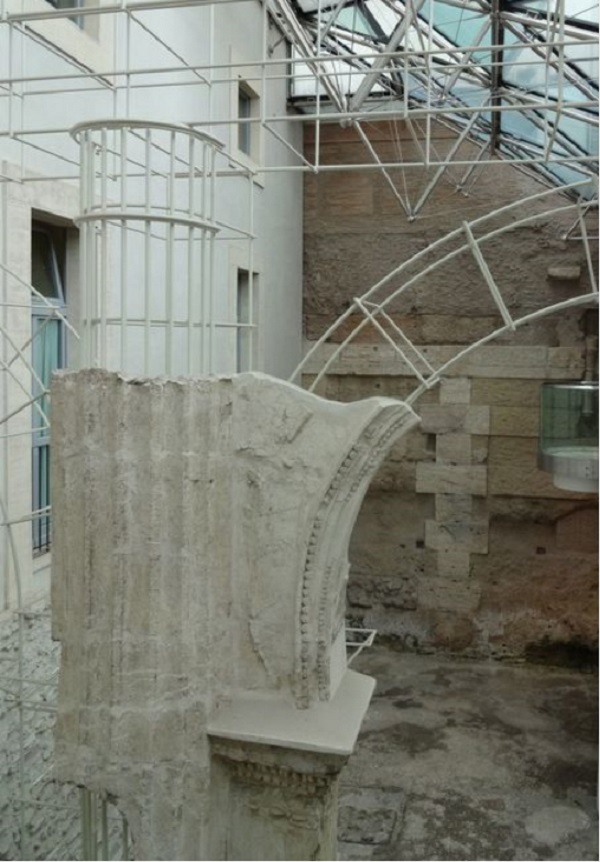
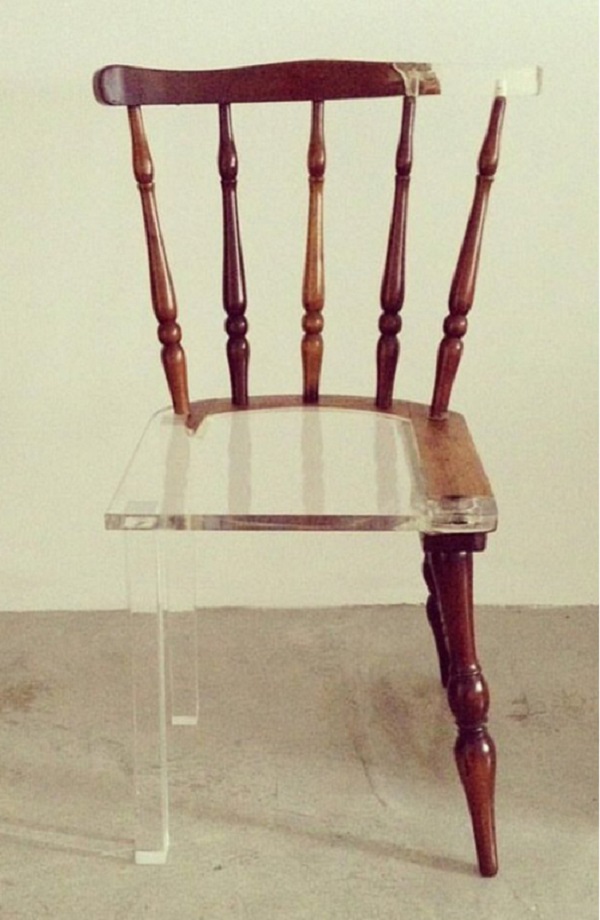
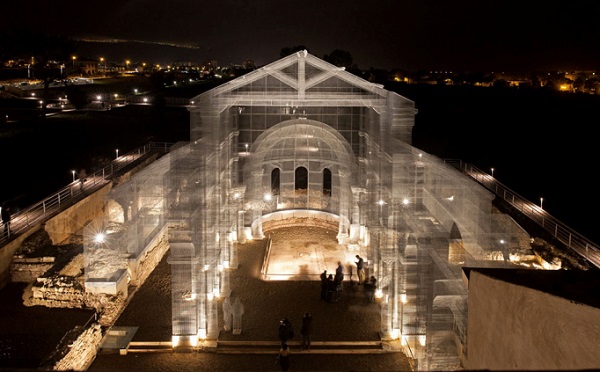
2 Glass as restorative material: the potential
While artistic restorations can give the sense of transparency using various means, in architectural restorations the transparent elements should contribute somehow to the consolidation of the damaged historic structure. This prerequisite discourages the exclusive use of steel elements and encourages the use of materials with inherent transparent and structural properties1. When such materials come into discussion, glass is the only one that creates an almost dematerialized intervention due to its transparent properties, durability and high compressive strength.
The developments in the glass industry have rendered it a very popular and widely used material during the modern times as a means to dematerialize the, up-to-that point impermeable, facades and create a direct connection between the interior and the exterior.
Consequently, it is not surprising that the first juxtaposition of transparent materials and historic buildings started around the middle of the 20th century, not always as a consolidation treatment, but rather as an attempt towards an open dialogue between the old and the new. The title of pioneer of this “transparent restoration” approach can be attributed to the Italian architect Franco Minissi (1919-1996), who created a novel architectural vocabulary in order to reveal the stratification of the monuments and reinstate their authentic image.
For him, transparency was a variable element to invoke the heritage value and enable its narrative to the present (Vivio 2014). Loyal to the principles of compatibility, reversibility and minimum intervention Minissi proceeded either with conceptual or literal restoration projects using Plexiglas and glass (Fig. 4a and b). However, due to poor maintenance, unsuitable bonding materials, the natural optical deterioration of plastic but also its “too modern” character, Minissi’s work failed to meet the functional requirements and did not receive the attention it should have.
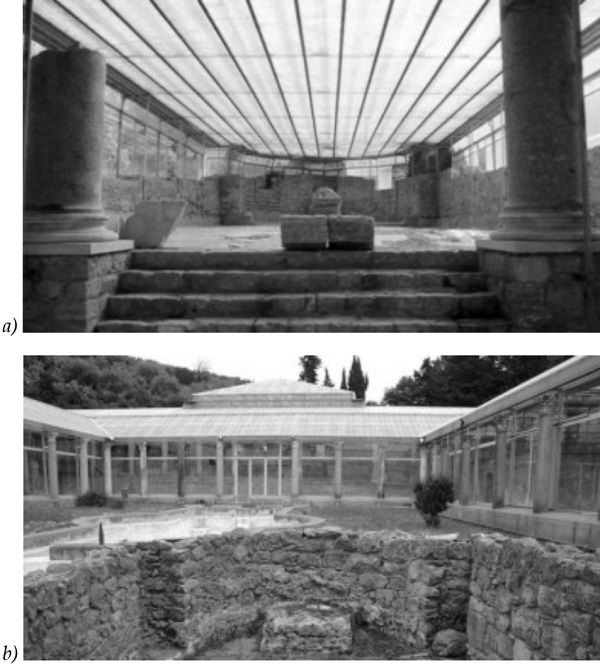
Today, the new technological advancements can overcome and provide solutions to the technical challenges of the past and glass can once again be explored as a promising restorative material. The latest technologies have turned glass into a competitive structural material, while the ability to see-through it converges with the demands for building skins that dissolve in the urban fabric. Advancements related to strength, safety and the declining need for supportive elements have led the way to all-glass structures of maximum transparency. The advantages of using glass in the restoration practice are related to both the theoretical guidelines, as well as feasibility aspects for the efficient consolidation and reuse of historic buildings.
1 A combination of glass and steel is always possible given that glass is the primary restorative material and steel has a secondary, supportive role (e.g. steel profiles can be used to protect the edges of glass panels).
2.1 Honesty
While from a conservation engineer’s perspective, glass has a lot to offer as a durable restorative material, its most valuable contribution to the conservation practice lies in its transparent nature. Restoring a damaged building by glass is the closest action of not restoring it at all; all traces of history are free to narrate their own story as “wounds that are healed but not hidden” (Frigo 2017, p. 25). In this context, glass is an honest material and acts as complementary and contrasting; it “bears the contemporary stamp” as suggested by the Venice Charter (ICOMOS 1964) and does not falsify the historic evidence.
Furthermore, through transparency, the monuments are related in a direct and honest way to their surroundings; the present setting and the way it has been shaped through the passage of time is what reflects their importance and values their cultural significance. Transparency can relate the structure to both its past and present setting, as it allows us to perceive the original volumes and, at the same time, the patina and natural ageing of our heritage, highlighting its unique and absolute character (Fig. 5).
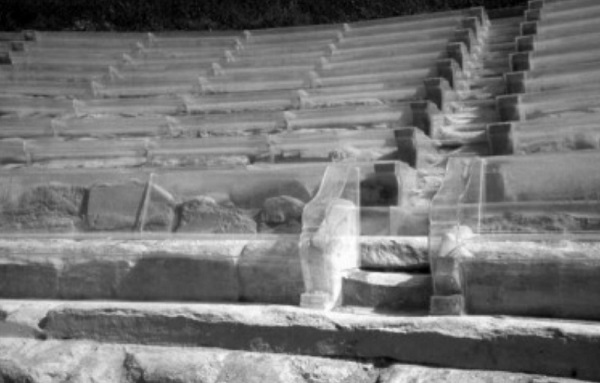
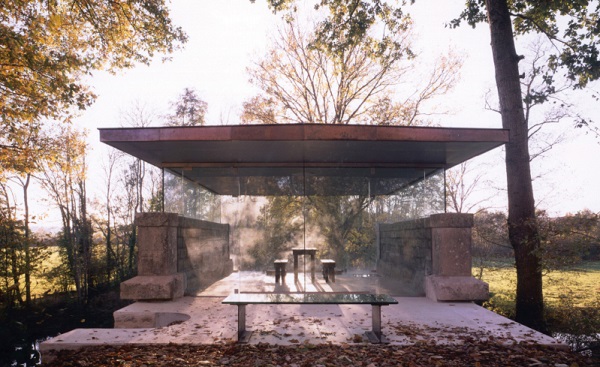
2.2 Structural performance
Historic structures employ brittle materials, such as stones or bricks, in large cross-sections that are primarily loaded in compression to form walls, arches and vaults. The high compressive strength of glass (Table 1) makes it a fitting candidate for the consolidation of structures that carry mainly compressive loads (Fig. 6). However, the value of examining a consolidation strategy lies in the way the modern materials are structurally collaborating with the old ones.
Compatibility of an intervention on a structural level aims to ensure the integrity of the historic fabric, so that the new materials will merely reinforce and not alter the existing structural scheme or act on the historic materials in a negative and harmful way (Teutonico et al. 1997 and van Balen et al. 2005, p. 784). In the case of glass, the term compatibility can refer to the balanced engineering of the new elements in the historic structure, bringing to the foreground aspects related to the form, configuration, construction techniques, connections and post-breakage behavior.
In general, the restoration techniques can be classified in two main categories: irreversible and reversible (Penelis et al. 1989). Irreversible solutions result in the permanent bonding between old and new materials with respect to their chemical, mineralogical, physical and mechanical properties. Such actions include grouting, deep rejoints, reinforcement with steel bars, stitching of walls with pre-stressed bars, skins of reinforced concrete on masonry, rebuilding of part of the facings of walls where these have fallen, interconnecttions of stone parts with bonded dowels or strengthening of foundations (IHBC 2017 and Penelis et al. 1996).
On the other hand, reversible actions may appear as external buttresses, ties at the springings of arches, rings at the base of domes, anastylosis of stone monuments with dry joints or new parts of the buildings to increase the strength, stiffness and ductility of existing diaphragms (Penelis et al. 1996). Usually, such techniques can employ modern materials imposing few restrictions to the historic structures (Penelis et al. 1996) and properties related to strength, stiffness, thermal expansion permeability and durability are more relevant to take into account.
Monuments and historical buildings are classified in hinged or articulated structures with dry joints (mainly classical temples and colonnades) and masonry buildings. Among the different materials used for their construction (cut natural stones, rubble, bricks, tiles, mortars, timber, iron clamps, dowels, chains etc.) only natural stones, bricks and mortars are called for structural co-operation with the new ones (Penelis 1996).
These new materials could be either traditional, such as stone, brick and timber, or modern ones, such as cast metal (iron, aluminum), stainless steel (for the connective elements), cast stone (cement-based), concrete, GFRC and FRP. In this context, glass is a modern material that can be used for reversible actions in order to enhance the overall structural integrity of the historic structures. Table 1 presents the comparison of the main properties of historic and other restorative materials compared to glass2, showing that the latter presents similar characteristics to the former and could cooperate successfully in consolidation practices.
2 Soda-lime and borosilicate glass show the greatest potential for architectural and structural applications.
Table 1: Properties of materials used in consolidation treatments derived from the Glass Construction Manual (Schittich et al. 2007) and CES Edupack 2017 Software (Granta 2017)

These values are based on the literature and may be intrinsically different in practice, while the values given for the historical materials (*) may differ with the presented ones due to other factors such as pathology and decay.
Glass is a much stiffer material than the traditional ones, which means that it does not require the same volume to carry the necessary loads. Historical buildings employ relatively weak materials (compared to modern ones like steel) in massive forms, while contemporary structures use stiff materials and rigid connections to attain flexible forms (Feilden 1982). The greatest advantage is that as less new material is needed, the intervention does not burden the monument with redundant weight.
Where a new stone masonry would cover the entire width of a damaged wall to structurally consolidate it, glass can be configured in plates and fins or cast glass masonry of minimum width with only using 25% of the equivalent original material (Barou 2016, p. 128). On the other hand, due to this stiffness difference, the weak historic structure could be damaged in case of overloading, as the modern structure would be strong enough to withstand the loads. The way these two parts of the consolidated structure are connected is a key element for the reinforcement strategy.
The connection between the old and the new should be designed as the weakest link that will fail first and act as a warning mechanism, protecting, in such way, the historic fabric (Vacharopoulou 2006, p. 750, Oikonomopoulou et al. 2016, Barou 2016, p. 200). Another crucial aspect of the design of the connection is the hydrothermal behavior of glass and any other materials used as interfaces, such as steel profiles and ductile interlayers. The heat, air and moisture distribution in historical buildings is achieved through porous materials that attribute natural breathing properties to the building envelope.
The hygric movement of historic materials appears as a critical aspect in modern restoration techniques, especially when non-expandable under the influence of moisture materials, such as glass, are used. This impervious nature of glass draws the attention to the thorough design of the connections, in order to ensure compatibility and avoid unwanted trapped water, condensation or moisture. As far as the thermal behavior is concerned, most types of stone have a comparable to borosilicate glass thermal expansion coefficient, resulting in connections with small gaps to accommodate the thermal movements. In the case of brick or soda-lime glass (with higher thermal expansion coefficient values, see Table 1), the connection has to allow for larger tolerances to avoid cracks and consequently the failure of the materials.
2.3 Indoor comfort
Glass, unlike other restorative materials, poses a great risk of creating unwanted indoor conditions related to overheating of the interior space, threatening the historic materials especially in warm climates. Compatibility in terms of energy performance can be achieved considering the orientation of the glass structure, passive ventilation solutions and coatings on the glass surfaces to improve the thermal performance (Fig. 7b and c) (Oikonomopoulou 2012, p. 95). On the other hand, the historic masonry walls have high thermal inertia, able to store heat and resist against temperature fluctuations (Fig. 7a). This facilitates the use of glass if the ratio between the glass and the existing surface remains balanced.

2.4 Durability
Glass is not only durable because it provides an excellent resistance against the elements and protects the sensitive historic fabric against weathering; more importantly, it is durable because it is legible over the years following a completely different decay pattern which distinguishes it from the existing materials and testifies its era (Fig. 8).
A question that often arises when traditional materials are used3 is how will they be detected years after their integration. With time, the contrast between old and new becomes obliterated and conjecture between the elements can occur without proper maintenance. Of course, the degree of weathering will vary in both the original and new members, but the original intention and selection of the material, its color and texture, collated to the existing ones seem to fade over time (Vacharopoulou 2006, p. 261).
Natural stones and ceramic products appear to fall into this category and the present state of the monuments shows how these restorative materials will look like to the eyes of our posterity. The aspect of durability and decay is important and should be taken into account when we discuss about the lifespan of an intervention. The durability of glass can be observed in the ancient churches, where, unless broken by excessive loads, glass provides service through the centuries of use and remains distinguishable compared to the adjacent materials.
Sudden temperature difference, unprotected edge finishes and mechanical stresses are some of the factors that affect the strength and consequently the durability (Pilkington 2018). When all these aspects, however, are taken into consideration in the design of the structure, the elements are not posing a huge threat to the surface quality of glass.
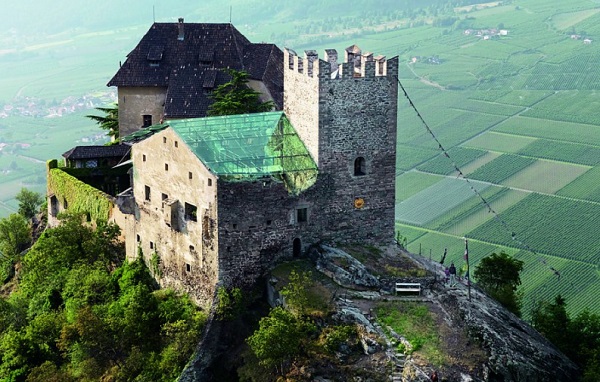
3 Especially in the practice of anastylosis, where materials similar to the originals are preferred.
2.5 Reversibility / Retreatability
The aspect of reversibility/retreatability of a restoration technique addresses the potential for future treatment of the monument (Teutonico et al. 1997 and van Balen et al. 2005, p. 784) and lies in the connections between the structural elements. When it comes to glass three are the possible ways to achieve this: with adhesive, mechanical (bolted) or embedded connections, followed by glass welding which is not applicable in building construction yet.
Due to maintenance and ease of replacement of damaged parts, mechanical and embedded connections are preferred compared to adhesives, offering the advantage of reversibility. In the context of restoration, adhesive bonding between the glass elements could be selected if maximum transparency is preferred, however, the connection to the historic materials should be achieved in a reversible way with dry connections, mechanical joints or soft interlayers (Fig. 9).
Current restoration treatments with traditional materials, could allow for the minimum damage of the original structure in certain cases and only if suggested by the restoration strategy after extensive research indicating that this is the only possible solution. A simple method, widely used today, is to insert tension rods by minimally penetrating the historic materials to prevent the structure from opening.
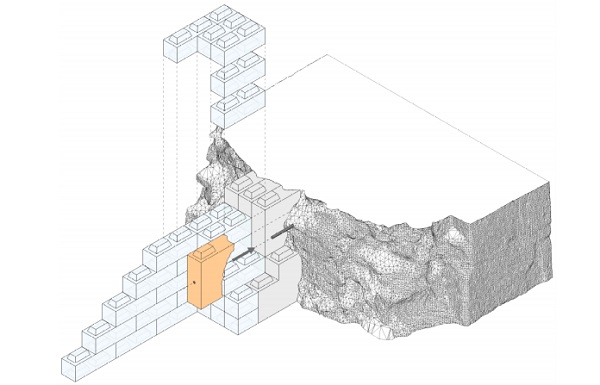
2.6 Aesthetics
For traditional restorative materials, aesthetic harmony is a term to express how the color, texture and details of the new members co-exist with the historic ones in a non-intrusive way. Glass is assumed a “colorless” material and in architecture we use it to create simultaneous perceptions and sensations of the interior and exterior spaces.
However, against the common belief, glass is not always transparent, colorless and flat, and when appearance is vital, as in conservation and consolidation treatments, aesthetics needs to be investigated in detail. Since transparency is the greatest benefit of using glass as restorative material, the degree of transparency and all the factors that can influence it need to be explored in order to highlight the challenges and potential. These parameters can be found on a micro, meso or macro-scale and are explained as follows:
• Micro-scale: Composition and surface treatment
At the microscopic level, the optical properties of glass highly depend on its chemical composition and the treatment of the surface, e.g. applied coatings. The basic glass recipe consists mainly of sand (silicon dioxide, SiO2), soda (sodium oxide, Na2O) and quicklime (calcium oxide, CaO), while the presence of metallic oxides is responsible for a special tint that each glass type has. Soda-lime-silica glass used in windows usually has a green tint caused by the high percentage of iron oxide (Fe2O3), while crystal glass, used for glassware, lenses and optical components, achieves higher levels of transparency due to the presence of lead oxide (PbO), zinc oxide (ZnO), barium oxide (BaO) or potassium oxide (K2O).
Other colorants, which can be used intentionally for customized products, are copper for blue, cobalt for dark blue, gold for dark red and manganese dioxide to decolorize colored glass (Corning 2011). In general, the density of glass, as a result of the combination of different chemical elements, affects the refractive index (how much the path of light is bent or refracted when entering a material) and consequently the transparency; the greater the density, the higher the refractive index and the more the distortion of the perceived image. Acid etching is a surface treatment used to attain a translucent glass surface, which emits scattered light and creates a hazy perception of the surroundings. Similar quality can be achieved by adding texture on the glass surface, using the methods of slumping, rolling or casting (Fig. 10a, b and c).
Coatings applied as a thin layer on the glass surface can also change the optical characteristics. For example, anti-reflective glass, used in facades, showrooms, shop windows etc., offers a crystal clear result and sharp perception, by reducing the reflections to just a fraction of those seen with conventional glasses (SCHOTT 2018). For restorative applications, on a microscopic level, glass could be engineered to achieve a specific color, tint or texture that matches the historic materials4, while an antireflective coating could minimize the reflections form the sun taking into account that most of our historic sites are perceived in natural daylight. In archaeological sites, for instance, which often ask for moderate light conditions in the form of diffused illumination, is recommended to make use of translucent glass instead of crystal clear for the canopies in order to provide sufficient protection against the intense sunlight.
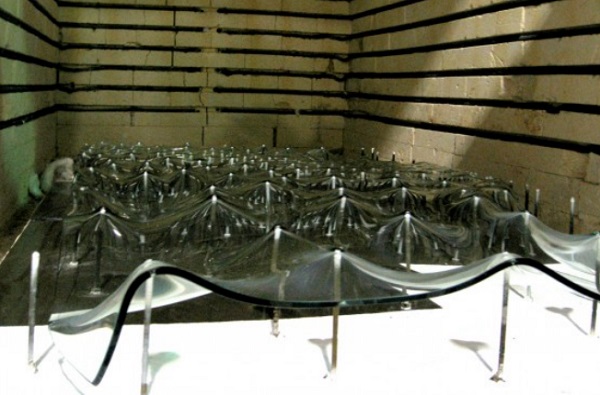


• Meso-scale: Geometry, configuration, scale and substructure
This category includes all those characteristics that affect the way we perceive the world and deal with how the glass elements are formed and arranged in space. The shape of the elements – flat, curved, round – is responsible for the faithful, or not, display of an image. Round elements, convex or concave surfaces create a distorted projected image as light rays are reflected in a different angle than the incident ones on the surface. Thicker elements can also create distortions compared to thinner ones; if we look at a glass pane perpendicularly it appears transparent, while if we look at it longitudinally it appears translucent.
This is more obvious when we stack glass panes on top of each other; they transmit light but prevent visual connection. Similarly, cast glass produced in larger thicknesses can create more distortion compared to thinner float glass, due to the larger distance the light has to travel through the medium. Given the fact that a flat glass surface can transmit, absorb and reflect the light, the more the layers the greater the optical illusions (Brzezicki 2017).
This phenomenon is evident in cavity geometries, such as hollow glass, where the double panes create more reflections and alter the perceived image, or alternatively, in the overall configuration of the structure. A monolithic cast glass wall would create less distortion than a wall of the same thickness comprising of fins and plates under certain angles of view; the more the overlapping elements, the greater the optical phenomena (Fig. 11).

Scale and rhythm of a glass structure are important and in close relation to the necessity for substructure, which can undermine its transparency and simplicity. The size and number of elements determines the number of connections between them. The Apple cube in New York is a great example of how scale affects the degree of spatial perception. The 106 glass panels and 250 primary fittings of the first structure in 2006 were replaced by 15 panels and 40 fittings in the second improved version in 2011, with significantly less intrusive elements (Eckersley O’Callaghan 2018).
Rhythm expresses the arrangement of the elements on the facade and the way we “read” it. The legible parts or modules can rely on the substructure that lies behind the glass, the sizes of the glass panes or the traces of connections. Depending on the restoration concept and the degree of transparency we want to achieve, distortions and translucency could be acceptable as long as the general feeling of the surrounding space is achieved.
4 Suitable for the restorative treatment of anastylosis
• Macro-scale: Lighting conditions
Since the term “transparent” expresses the property of “permitting the uninterrupted passage of light” (British Dictionary), the lighting and viewing conditions can influence the transparency of glass. Depending on “the time of the day, the angle of the sun and the weather conditions glass can be both reflective and transparent” and “material transparency is converted into material opacity” (Blau 2010). This reflection could result either in a great asset, enabling the continuity of space or a great threat over a historic monument creating an overwhelming opposition and imposition.
The function of the historic building after restoration treatments with glass is also crucial as it determines its principal character and interaction with the visitors. In the case of Louviers Music School’s extension in France, the mirror finish of the new glass façade appears discreet during the day, reflecting its surroundings and allowing for space continuity and turns transparent during the night exposing its interior (Fig. 12a and b).
However, most of our historic settings are visited during the day and under, sometimes, extreme daylight conditions. Too many reflective surfaces would create disturbance in our eyes, without being able to focus, as glass would prevail over the historic materials. Contrast is acceptable and encouraged for new materials as an evidence of the era, but at the same time, demands critical thinking taking all the variables into account.
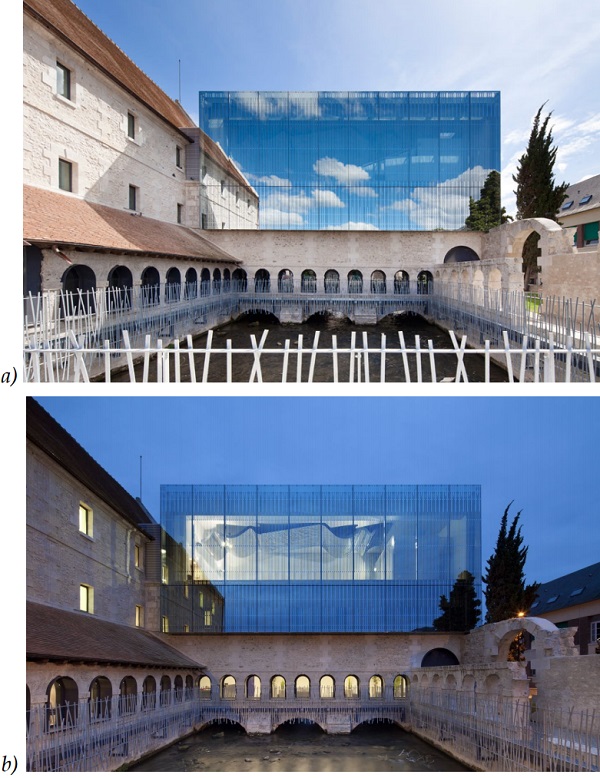
3 Methodology
The advantages of glass as building and restorative material can create a fruitful platform for further discussion and exploration of materiality aspects in the field of restoration and conservation. However, in order to translate this potential into a feasible restoration methodology we need to take into account three key parameters: the degree of intervention, the degree of representativeness and the fitness of the available glass products and configurations. All these aspects are related to each other and should be tackled as intertwined parts of the restoration strategy in order to achieve a successful intervention employing transparency.
3.1 Degree of intervention
We have all encountered glass in close relation to historic artifacts; museum showcases usually use PVB laminated low-iron and anti-reflective glass to protect the sensitive materials against UV radiation and for security reasons (Lord and Piacente, 2014, p. 306). Glass floors on top of archaeological sites are often used to access and “walk through” the degraded ruins, as appear at the New Acropolis Museum in Athens. Although not frequent, there are a few more applications of glass for restoration purposes presented and discussed in this research. These can be divided in four categories according to the conservation aim of:
• Protection of the historic fabric
Glass can act as a protective element for the sensitive historic materials not only inside a museum. With the passage of time, buildings exposed to the elements are in risk as the materials become weak and consequently the structure loses its structural capacity. Glass can seal effectively these sensitive parts forming a durable protective layer against most harmful weathering conditions (e.g. sea salt or frost). Archaeological sites are a common example of exposed materials, where the protective canopies do not only provide a shelter for the historic building remaining, but also create a pleasant environment for the visitors.
The case of St. Maurice Abbey (Fig. 13a) is particularly interesting, since the intervention does not only protect the archaeological site, but is a reminder of the catastrophic damage caused by rock sliding. The new translucent canopy maintains a physical and conceptual connection to the history of the site. The scattered rocks on top of it create and even and dispersed light to the ruins below and prevent the uplifting of the structure from the wind blasts (Detail Daily 2012).
In historic buildings, roofs were made by lightweight materials such as wood, which have not survived until today, resulting in uncovered parts of monuments. A glass roof could serve as way to, not only invoke the authentic form, but also protect the sensitive historic parts from further degradation. The church of Corbera d’ Ebre is an example of such restoration with transparent materials (Fig. 13b). The collapsed roof is replaced by a transparent structure of steel frames and ETFE foil as infill to provide cover and improve the conditions of habitability. The use of transparent materials preserves the subtle balance between nature and construction, as well as the memory of the civil war as inseparable part of the history of the place (Ferrán Vizoso Architecture 2017).
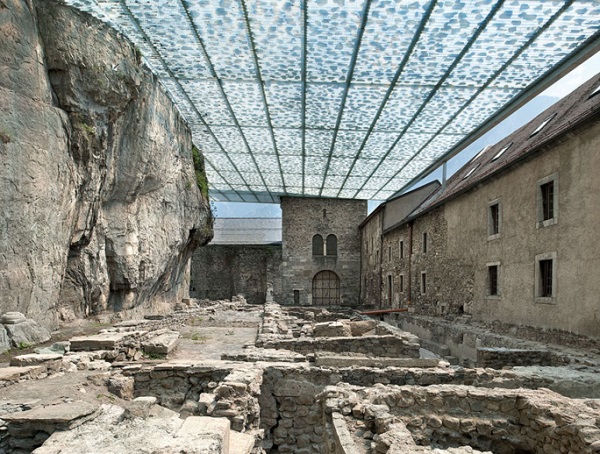
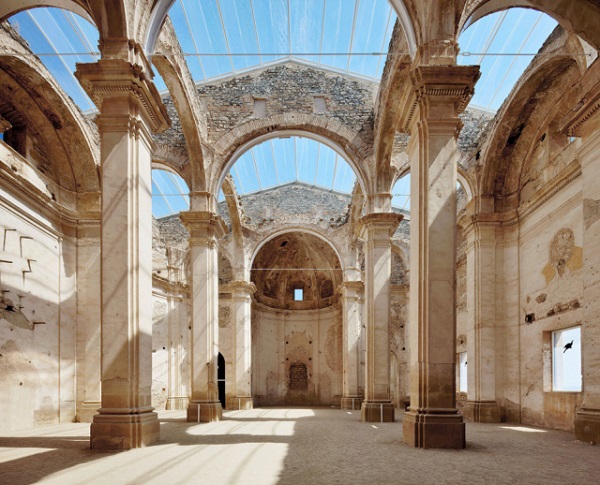
• Reinforcement by filling of the form
Natural (e.g. earthquakes) or man-made (e.g. wars) factors are responsible for the collapsed parts of our historic buildings, changing the loading conditions and the stability of the structure. Filling of the form with glass walls, roof or floors preserves the original shape and enhances the diaphragmatic behavior of the whole. The case of Bembo’s Bastion in Greece suggests the consolidation of a bastion, part of an archaeological site, with structural glass masonry (Fig. 14). The glass structure consolidates the remaining walls creating horizontal connections to the freestanding elements and enhances the mechanical behavior of the structure as a whole (Barou 2016).
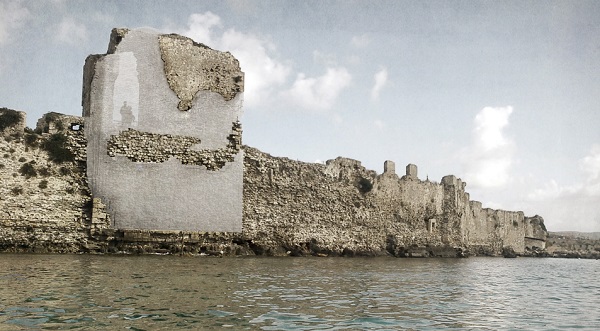
• Adaptive re-use
Monuments are not only parts of our built heritage but also of our building stock and their re-use contributes to the sustainability of our available resources. Restorations aiming at the re-use or rehabilitation strategy of a historic building can employ glass elements either as a means to close the in-between spaces (colonnades, patios and arcades) or as part of an extension, usually of abstract form, to create viable indoor conditions and accommodate new functions.
Both the cases of Bombay Sapphire Distillery and St. Francis convent show the potential of glass in extension structures that can completely transform a historic building (Fig. 15a and b). The former intervention accommodates two glasshouses that recycle the waste heat coming from the distillation process, while the latter accommodates a new entrance for the convent, which is converted into an auditorium. Both structures introduce abstract contemporary forms that relate to the adjacent buildings in a distinct but harmonic way.
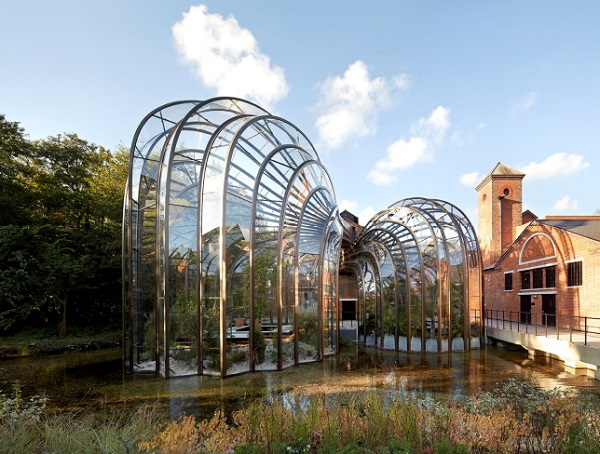

• Reproduction of craftsmanship
Decorative elements have always been part of the identity of historic buildings. From coats of arms to Corinthian rhythm columns, these special crafts or features are historic evidence of the time and the cultural, social, political, religious or architectural character of our monuments. The reproduction of such elements with glass can maintain this character and transfer it to the present time forming an open dialogue between the old and the new. The Crystal Houses in Amsterdam is one of the cases that clearly present this potential (Fig. 16).
Cast glass masonry is chosen to replace the lower part of the façade and slowly transforms into the traditional brick masonry at the top. The glass structure preserves not only the original construction technique, but also the exact proportions of the original masonry, creating a unique façade without compromising the historical ensemble (MVRDV 2016). In a similar way, other historic buildings could be restored maintaining the main analogies of the forms and elements, using glass to highlight the intervention.
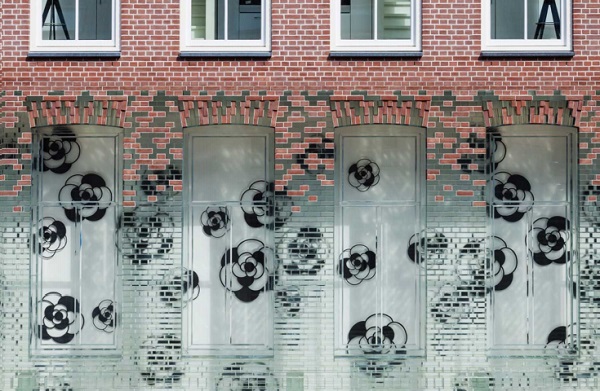
3.2 Degree of representativeness
An efficient tool, which can indicate the most appropriate restorative approach, is the level of representativeness; in what degree the new structure will resemble to the existing one or not. This critical decision-making depends, to a large extent, on the evaluation and interpretation of the monument based on the available documentation but also the requirements related to the pathology and degree of intervention. An analytical values-based approach can determine the social, spiritual/religious, educational, symbolic and aesthetic values and finally the cultural significance of a place of memory. Kerr (2004, p. 16), Worthing and Bond (2008, p. 91) add that age, vulnerability, rarity, influential impact or representativeness of their kind is equally important in this equation.
A rule of thumb is to treat older monuments with greater respect and sensitivity depicted in their conservative restoration strategy, such as the practice of anastylosis. In these cases the accurate representation of the missing elements and the revival of the original form is preferred. On the contrary, recent historic structures could tolerate a more abstract and flexible form in terms of design, especially when they are combined with the adaptive reuse of the space and are part of a branding strategy (Fig. 17a, b and c).
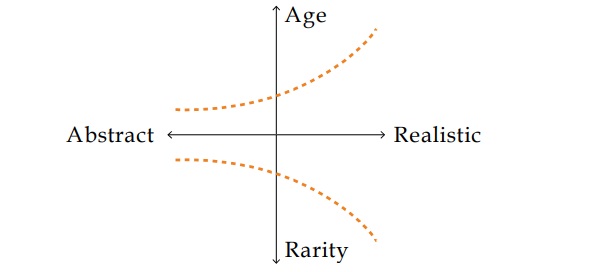
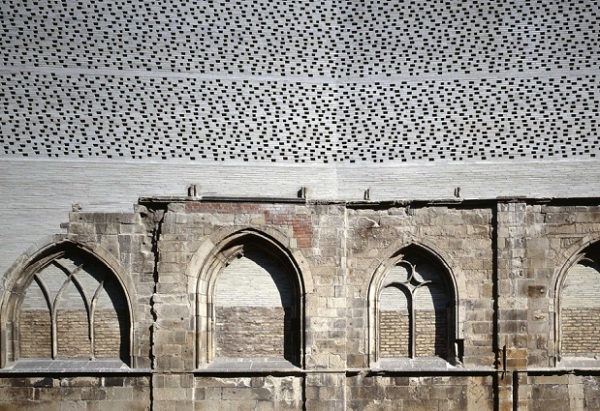
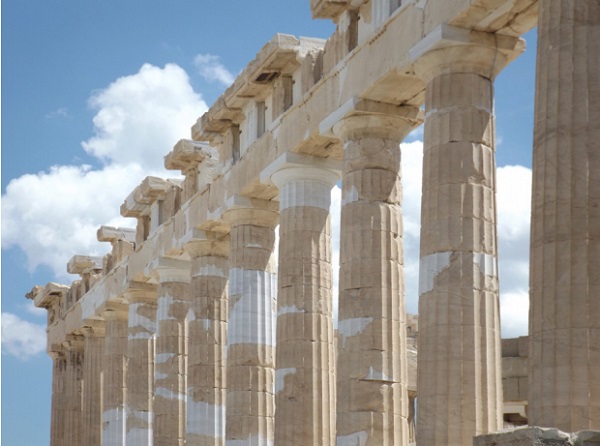
3.3 Assessment of glass types
Having discussed all the challenges and potential for the use of glass in the conservation of historic buildings – structural compatibility, aesthetics, reversibility – one aspect remains to be investigated: what are the available glass products today and how can they be employed in our restoration concept? The fabrication techniques pose a major driving force for the implementation of the material in restorative practices and determine the degree of harmonization with the historic setting. The available glass used for architectural and structural applications today is limited to float, cast or extruded components. Each of them has different qualities to offer, regarding the possible configurations, scale and degree of transparency and, therefore, meets a specific range of possible restorative applications. An overview of the general characteristics and applicability of the glass types is shown in Table 2.
Table 2: Assessment of the different types of glass with respect to configuration, scale, transparency
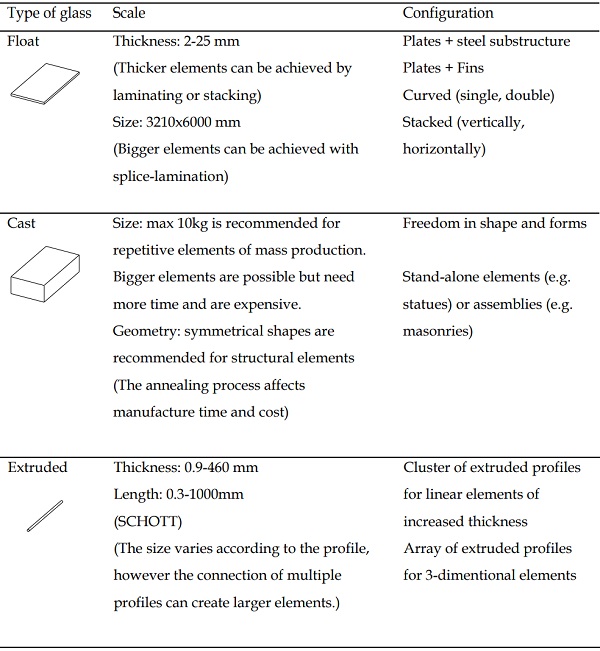
• Float glass Float glass appears as a good candidate for abstract restorative solutions as its limited thickness and 2-dimentional nature create a well-defined geometry that easily distinguishes from the one of historic structures. All the configurations generated using float glass can give a rough impression of the building, outlining its main shape and
and applicability in restoration practices
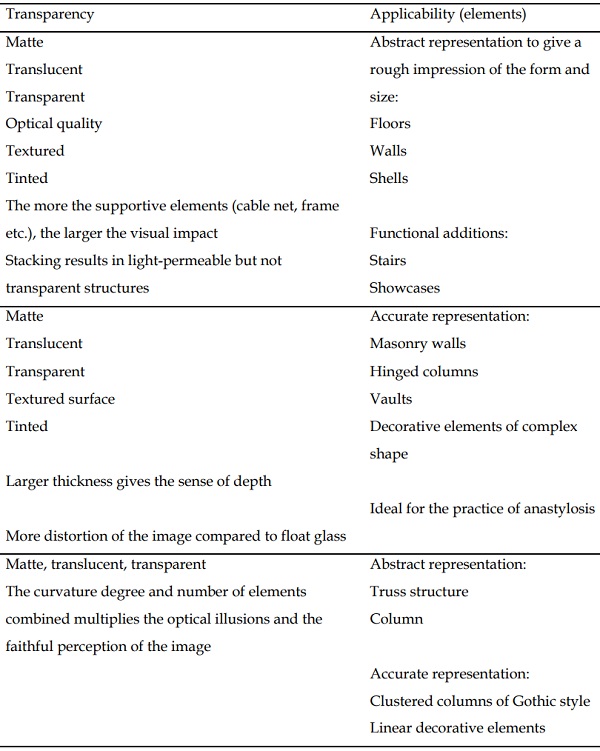
proportions without details of the workmanship or the construction techniques (Fig. 21a). Interventions aiming to the protection of historic materials, as well as those that give a new adaptive character to the monuments can tolerate a higher degree of freedom for the design of the new glass structure. Solutions with abstract forms are a rather suitable approach as an indirect treatment, which can safeguard our built heritage and simultaneously stand out as iconic additions. The glass shell of the Canadian Museum of Nature stands for the memory of the original part in a completely contemporary form, which respects, however, the original volume and scale (Fig. 18)
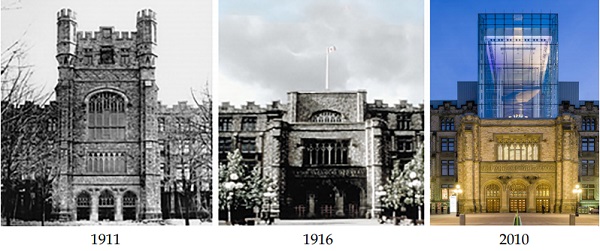
Abstract solutions with float glass can also be the answer for monuments of later eras in order to fill the form and strengthen the collapsed parts of a building. As glass is in close proximity to the historic materials, the new design should preserve the rhythm and aesthetic quality of the existing one in a harmonic coexistence. Float glass can be articulated in a way to follow the grid and main lines of the historic structure either with the right dimensioning of the elements or the position of the substructure (Fig. 19a). Float glass is not only configured in fins and plates, horizontally or vertically stacked elements can create massive glass walls, which on the one hand may decrease the overall transparency, but on the other hand create a rather interesting and unique result, such as the case of the Magdalena’s fountain adaptive restoration (Fig. 19b).
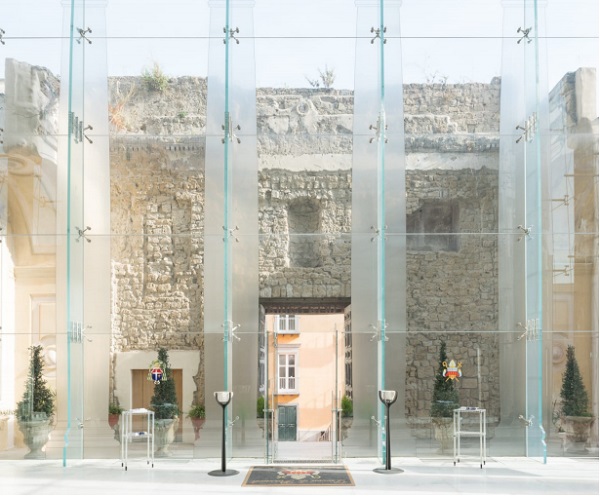

• Cast glass
The flexibility in forms that can be attained using cast glass is the best solution for restoration treatment aiming to resemble the original shape as faithfully as possible. Glass casting offers the sense of depth, the 3rd dimension that float glass lacks, and can produce complex volumes with thicknesses similar to the historic elements. In this context, ornamental or other architectural elements, that express the unique identity of a historic setting, could be reproduced in cast glass, with a high level of precision and detail (Fig. 20).

Fig. 21b illustrates the proposed restoration of the Lichtenberg Castle in Maastricht with cast glass masonry. The masonry consists of interlocking units, which are translucent and textured in order to match the appearance of the existing historic masonry and at the same time retain their distinct character (Oikonomopoulou et al. 2017). In a similar way cast glass monolithic elements would be ideal for the practice of anastylosis, placed in-between the remaining structure, which appears to float in the air.
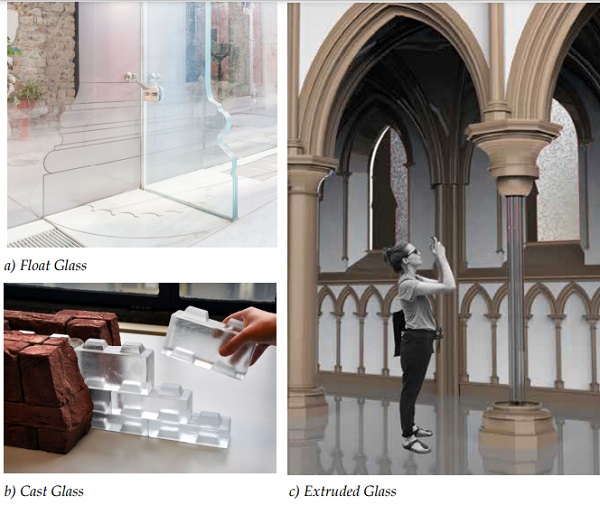
• Extruded glass
The use of extruded glass could be adequate for the restoration of linear structural elements of standard cross-sectional area, such as gothic columns (Fig. 21c). In a smaller scale, glass profiles could also be used as ornamental elements of very small thicknesses that cannot be achieved by cast glass. Special thermal treatment could be considered to add flexibility and freedom to the shape. A modern and abstract configuration of extruded glass profiles is also possible in the form of truss structures, to create lightweight horizontal components.
3.4 Comparative restoration strategy with structural glass
As discussed in the previous chapters, the methodological approach of a restoration concept using structural glass suggests first the assessment of the monument, in order to indicate the level of representativeness of the intervention. The next step is to choose the appropriate glass products according not only to the restoration concept, but also to the consolidation demands and the degree of intervention. The assessment of the different glass types (Table 2) and the presented examples show that cast glass should be preferred for a realistic representation of the historic elements, while float glass should be preferred for more abstract representations and treatments. Extruded glass could be used in exceptional cases for both approaches, depending on the context (Fig. 22). Nevertheless, in reality a combination of more than one glass type should be considered, as multiple parts of the same structure could ask for different actions.
Other factors that affect the choice of the glass is the loading conditions and constrains, as well as the cost. The position of the glass element suggests different glass configurations according to the consolidation demands. For instance, a collapsed roof is more likely to be restored by a lightweight glass structure with float glass than a cast glass masonry, in order to burden the historic materials as little as possible. Furthermore, cast and extruded glass are significantly more expensive than float glass and it is no coincidence that the latter monopolizes the contemporary glass structures of our time. Post-processing, such as surface or thermal treatments, and time-consuming construction can result in unwanted and expensive structures.
4 Conclusions
The introduction of glass elements for the restoration of our monuments appears as an elegant solution to attain the tangible and intangible character of historic structures; an attempt to revive the original form, but at the same time respect the stratification and the layers of history, including the present time and the surrounding landscape. Glass offers a contemporaneity to the historic materials and demonstrates the spirit of our era and the dominance of cutting-edge technology and innovation as part of our everyday life.
Today, it is of vital importance to treat our historic heritage with honesty and apply materials and techniques that leave no room for conjecture. The unique transparency of glass gives a sense of immateriality; the volumes and shapes dematerialize and the perception of our ruins turns into a trick of the spatial acuity of our eyes.
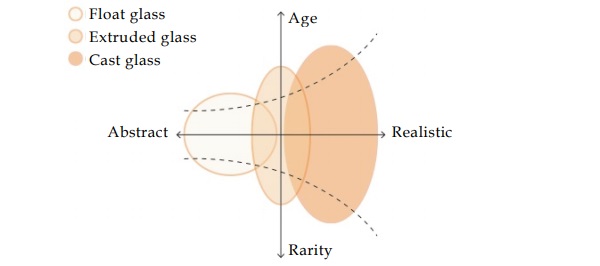
The feasibility of the concept is explored through a study on compatibility, reversibility and durability aspects, as prerequisites for any consolidation practice, and relies on the proper engineering of the glass structure in terms of connectivity, structural and climate performance in respect of the historic fabric. The aesthetic quality of glass and transparency can be interpreted in different ways; transparent surfaces allow for a clear, distorted or blurry perception of the surroundings or merely permit light transmission, concealing any peripheral views.
Each glass structure can achieve different qualities depending on the geometry, configuration or treatment, and should always match the restorative concept, degree of intervention and level of representativeness. Nevertheless, the lack of any delineated principles of how to restore a decayed structure leads to tailormade solutions, as there is no universal cure to heal various illnesses.
The state-of-the-art technology and continuous progress on glass fabrication, processing and assembly brings transparent materials to the foreground for applications of strengthening our decayed historic structures towards the sustainable exploitation and preservation of our built heritage for future generations. Based on the above, a methodology is developed as a toolbox of design possibilities regarding the existing glass products and their applicability, in order to highlight the aesthetical and engineering value of using and considering glass a restorative material.
References
Arkitexture: Bombay Sapphire Distillery: Thomas Heatherwick’s Botanical Beauty (2015) http://arkitexture.com/inspiration/bombay-sapphire/ Accessed on 12 June 2018
Avrami, E., Mason, R. and de la Torre, M.: The spheres and challenges of conservation. In: Values and Heritage Conservation, research Report. Los Angeles, The Getty Conservation Institute (2000)
Architizer: Consolidation of the Matrera Castle Keep Tower. (2015) https://architizer.com/projects/restoration-of-matrera-castle/ Accessed on 12 June 2018
Barou, L.: Transparent Restoration. MSc Thesis. Faculty of Architecture and the Built Environment, Technical University of Delft (2016)
BaseHEIGHT: Warped Panes: Experiments in Slumped Glass (2017) https://www.baseheight.com/home/portfolio-item/warped-panes-experiments-inslumped-glass/ Accessed on 3 January 2018
Blau, E.: Inventing New Hierarchies. Laureates Essay for the Pritzker Architecture Prize, The Hayatt Foundation. 1-7. (2010)
Brzezicki, M.: Recent Trends in Architectural Design of Light-permeable Facades. GPD Glass Performance Days Conference Proceedings. Finaland (2017)
CIRCARQ: La antigua central eléctrica del Mediodía. (2013) https://circarq.wordpress.com/2013/10/21/la-antigua-central-electrica-delmediodia/ Accessed on 12 June 2018
Corning Mueum of Glass: Chemistry of glass. (2011) https://www.cmog.org/article/chemistry-glass. Accessed on 17 January 2018
Corning Mueum of Glass: What is glass?. (2011) https://www.cmog.org/article/what-isglass. Accessed on 17 January 2018
Cuac Arquitectura: Fuente de la Magdalena In: Divisare (2018) https://life.divisare.com/projects/222118-cuac-arquitectura-javier-callejas-sevillaraudal. Accessed on 12 June 2018
D’Ayala, D.F. and Forsyth, M.: What is conservation engineering? In: Structures and construction in historic building conservation. Blackwell Publishing Ltd (2007)
Dent, A.: A prison, a church, a music school: music school Louviers extension by opus 5. (2012) http://thefoxisblack.com/2012/10/03/a-prison-a-church-a-music-schoolmusic-school-louviers-extension-by-opus-5/ Accessed on 12 June 2018
Detail Daily: A rocky covering for the ruins of the Abbey of St. Maurice, Switzerland by Savioz Fabrizzi Architects. (2012) https://www.detail-online.com/blog-article/arocky-covering-for-the-ruins-of-the-abbey-of-st-maurice-switzerland-by-saviozfabrizzi-architects-25452/ Accessed on 12 June 2018
Dewaele, H.: Wonderful Crete (2015) http://www.hansdewaele.com/?p=1989 Accessed on 12 June 2018
Feilden, B. M.: Conservation of historic buildings. Butterworth Scientific. London (1982)
Ferrán Vizoso Architecture: Restoration of the old church of Corbera d'Ebre by Ferran Vizoso Architecture. (2017) https://www.metalocus.es/en/news/restoration-oldchurch-corbera-debre-ferran-vizoso-architecture Accessed on 12 June 2018
Fleșeriu, A., Eszter, P.: Reframe. ArchDaily. (2016) https://www.archdaily.com/795982/reframe-alexandru-fleseriu-plus-peter-eszter/ Accessed on 10 Jan 2018
Frearson, A.: Auditorium in the Church of Saint Francis' Convent by David Closes. (2012) https://www.dezeen.com/2012/07/26/convent-de-sant-francesc-by-david-closes/ Accessed on 12 June 2018
Freitas, T.: New old chair. (2010) https://www.tatianefreitas.com/projects/6070852 Accessed on 10 January 2018
Frigo, M.G.: Restoration of partially collapsed historic walls using interlocking cast-glass components: The case of San Michele Castle in Cagliari, Politecnico di Milano (2017)
Gnossis Architettura and Bardeschi, M. D.: Cathedral of Pozuoli In: Divisare (2017) https://divisare.com/projects/346310-gnosis-architettura-marco-dezzi-bardeschimariano-de-angelis-francesco-cimmino-cattedrale-di-pozzuoli Accessed on 15 December 2017
Granta: CES Edupack 2017 [Computer software] (2017)
ICOMOS: International Charter for the Conservation and Restoration of Monuments and Sites (The Venice Charter 1964). IInd International Congress of Architects and Technicians of Historic Monuments. Venice (1964)
IHBC: Restoration. https://www.designingbuildings.co.uk/wiki/Restoration. (2017) Accessed on 16 January 2018
Kerr, J.S.: The Conservation Plan (6th edn.). In: Worthing, D. and Bond, S.: Managinf Built Heritage. The role of cultural Significance. (2008)
Kraaijvanger: Temple de l’ Amour II (2018) https://archello.com/project/temple-delamour-ii Accessed on 12 June 2018
LaMonte, K.: Reclining dress impression with drapery. Smithsonian American Art Museum & Renwick Collection (2007) http://www.karenlamonte.com/Museum-ArtCollections/Smithsonian-Museum-Renwick-Gal/ Accessed on 28 December 2017
Lord, B. and Piacente, M.: Manual of museum exhibitions, 2nd edition. Rowman & Littlefield (2014)
Marigliani, A.: Museo Nazionale Romano – Crypta Balbi. (2014) http://www.archidiap.com/opera/museo-nazionale-romano-cryptabalbi/?_sf_s=crypta%20balbi Accessed on 12 June 2018
MVRDV: Crystal Houses (2016) https://www.mvrdv.nl/projects/crystal-houses. Accessed on 12 June 2018
Oikonomopoulou, F.: Pure Transparency. Master thesis. Delft University of Technology, Faculty of Architecture, Department of Building Technology (2012)
Oikonomopoulou, F., Bristogianni, T., Veer, F., Groot, C., Karron, K. and Nijsse, R.: Restoring and structurally reinforcing historic monuments by glass. Proceedings of SEMC conference, South Africa (2016)
Oikonomopoulou, F., Bristogianni, T., Barou, L., van Hees, R., Nijsse, R., Veer, F., Schellen, H., van Schijndel, J. (2017). Restorative glass: Reversible, discreet restoration using structural glass components. SPOOL, 4(2). doi:10.7480/spool.2013.1.624
Penelis, G. G., Karaveziroglou, M. and Papayianni, J. Materials for repair of Masonry Structures. In: Proc. of Conf. on Structural Repair and Maintenance of Historical Buildings, Florence, (C.A. Brebbia, ed.), 161-170. Computational Mechanics Publications, Southampton, Boston (1989)
Penelis, G. G.: Teqniques & Matrials for Structural Restoration. Eleventh World Conference on Earthquake Engineering. Paper No. 2089. Elsevier Science Ltd (1996)
Pilkington: Durability of Glass. https://www.pilkington.com/en-gb/uk/architects/glassinformation/functions-of-glass/mechanicalfunctionsofglass/durability. (2018) Accessed 16 January 2018
Riegl, A.: The modern cult of monuments: ts essence and its development. In: N.R. Price, K. Talley J rand A.M. Vaccaro (eds) Historical and Philosophical Issues in the Conservation of Cultural Heritage. Los Angeles, The Getty Conservation Institute (1902)
Schott: Schott Amiran® – anti-reflective glass for facades. (2018) http://www.schott.com/ architecture/english/products/anti-reflective-glass/amiran.html. Accessed on 18 January 2018
Schittich, C., Staib, G., Balkow, D., Schuler, M. and Sobek, W.: Glass Construction Manual. 2nd Edition. Birkhauser (2007)
Teutonico, J. M., Charola, A. E., De Witte, E., Grasegger, G., Koestler, R. J., Laurenzi Tabasso, M., Sasse, H. R., and Snethlage, R. (1997), Group Report How Can We Ensure the Responsible and Effective Use of Treatments (Cleaning, Consolidation, Protection)?” Dahlem Workshop on Saving Our Architectural Heritage: Conservation of Historic Stone Structures, Baer, N. S. and Snethlage, R. (Eds), Chichester, John Wiley & Sons, pp. 293-313
Tresoldi. E.: Basilica of Siponto (2016) https://www.edoardotresoldi.com/works/basilicaof-siponto/#&gid=1&pid=1 Accessed on 13 January 2018
Tresoldi, E.: The Metaphysical ruin (2017) https://www.edoardotresoldi.com/concept/ Accessed on 13 January 2018
Vacharopoulou, K.: Conservation of Classical Monuments: A Study of Anastylosis with Case Studies from Greece and Turkey. PhD thesis. Institute of Archaeology, University College London (2006)
Van Balen, K., Papayianni, I., Van Hees, R., Binda, L. and Waldum, A. (2005). RILEM TC 167-COM: Characterisation of old mortars with respect to their repair, Introduction to the requirements for and functions and properties of repair mortars, Materials & Structures, Oct. 2005, pp 781-786
Van den Broek, E. A. M.: Exploring the effects of post-tensioning an all glass column of the bundled type to enhance slenderness and promote safe failure behavior. Master thesis. Faculty of Architecture and the Built Environment, Technical University of Delft (2017)
Vivio, B. A.: Transparent Restorations: How Franco Minissi Has Visually Connected Multiple Scales of Heritage. Future Anterior, 11. doi:10.1353/fta.2014.0014 (2014)
Wegstudio: Oratorio dei Filippini, Conversione a sala concerti. (2018) http://www.wegstudio.it/portfolio/oratorio-dei-filippini/ Accessed on 12 June 2018
Worthing, D. and Bond, S.: Managing Built Heritage. The role of cultural Significance. Blackwell Publishing Ltd (2008)


